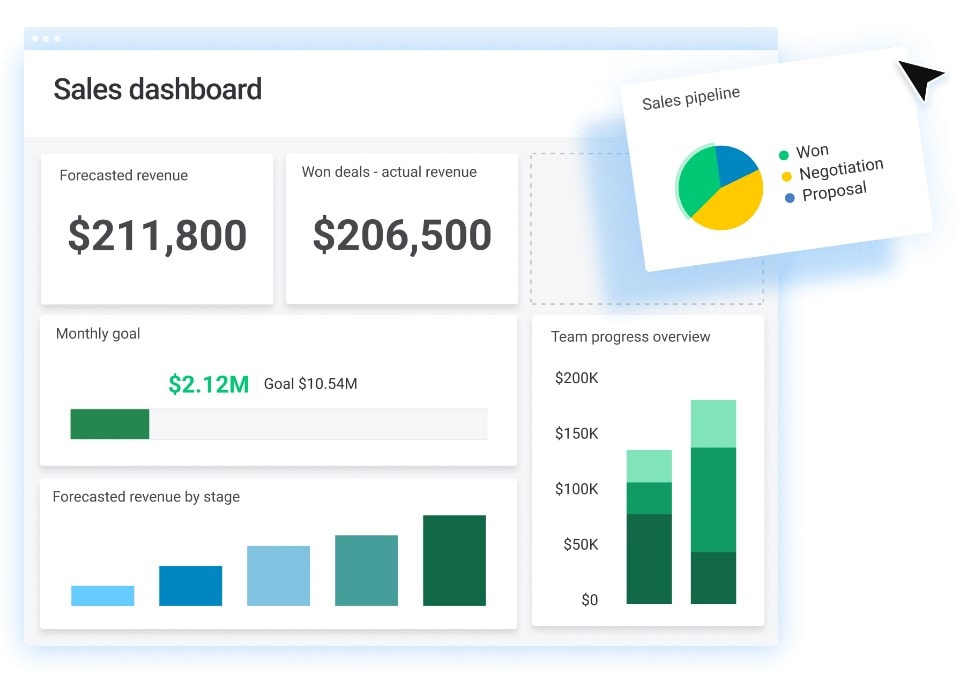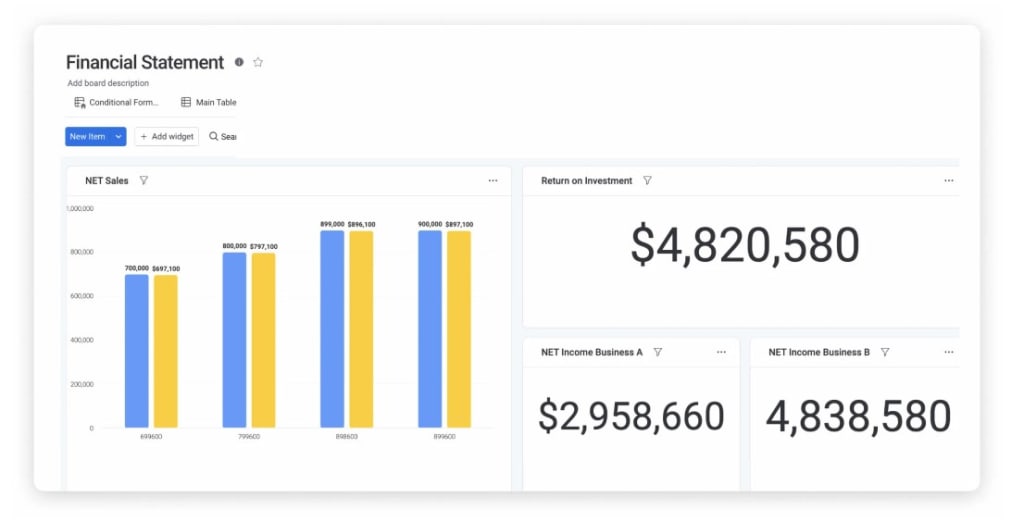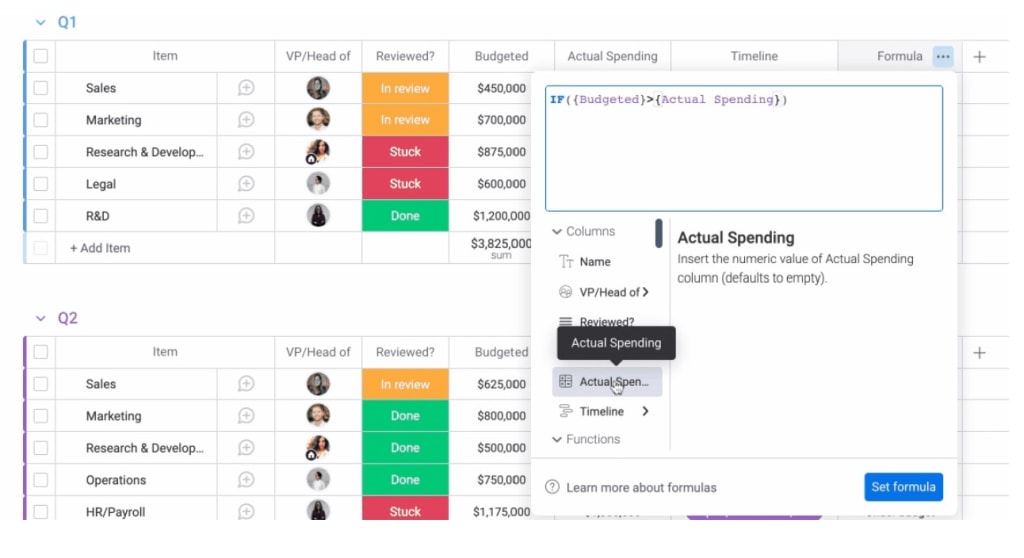Business owners are rarely just in it for the ride—they want to make money. That’s why tracking and reporting sales revenue is critical. This metric gives you an insight into what your blood, sweat, and tears are generating in hard-earned cash.
Sales revenue is only one of the calculations you’ll make to determine the financial health of your business, but it’s an important starting point. Let’s get into it and look at the steps to track and report sales revenue in monday.com.
What is sales revenue?
Sales revenue is a metric that calculates the value of products or services sold over a set reporting period.You might track sales revenue on a monthly, quarterly, or annual basis, and you can adjust this to suit your needs. For example, if you typically track annual revenue, but want to measure the success of a new product launch, then temporarily switching to monthly sales revenue reporting could make sense.
There are two types of sales revenue to consider: gross and net.
- Gross sales revenue is your bigger number. The figure accounts for the total of all product or service sales. It’s a useful metric if you want to track your sales teams’ success at selling to customers.
- Net sales revenue is a more accurate way to determine how much income your business is generating. Calculate net sales by subtracting any returns, discounts, or allowances from your gross sales revenue. For example, if you run a 10% off sale or need to refund customers their shipping fee, you’ll subtract these from your gross sales to provide your net sales revenue.
Why is sales revenue important?
Calculating sales revenue alone doesn’t tell the whole story about your business finances. You’ll also want to track numerous other metrics, such as your tax, expenses, and profit.
Nevertheless, revenue deserves its place on the top line of your income statement. Not only does this figure help deliver a clear picture of your business’ sales health, but it’s also useful for the following:
Planning out operating expenses
Operating expenses are directly tied to your revenue figures. Costs such as advertising spending and sales personnel must all be paid for out of your revenue, so you’ll want to keep these expenses in check. But equally, savvy investment in these areas can also boost your sales revenue.
As a rule of thumb, use an operating expense ratio (OER) of 60 to 80% to measure the operating cost of generating revenue versus the income generated from it.
Analyzing historic revenue trends
Unless you’re a startup, you should have historical revenue data to pore over. Looking back at your sales figures will allow you to spot revenue trends and respond accordingly.
For example, if your sales data highlights that revenue soars around the holiday season, you can invest in marketing resources in the run-up to ensure you have an enviable pipeline full of leads to sell to.
Forecasting and setting revenue targets
Gartner research shows that only 45% of sales leaders have confidence in their current sales forecasting. But analyzing sales revenue numbers can turn this around.
Make sure your data is clean and error-free to make the most accurate predictions. Then carefully track and report your revenue in a centralized Work OS for the most collaborative approach to forecasting.
From here, set revenue targets for your sales and marketing teams to hit. Build your KPIs based on your forecast and promote accountability by tracking these as a team in your Sales CRM.
Valuing a business
A standard valuation method for selling or acquiring a business uses a times-revenue calculation where the price of a business is worth one or two times the annual sales revenue figure.
For example, if a printing company takes $1 million in annual sales revenue, you might reasonably value the business between $1 million and $2 million.
How do you calculate sales revenue for a product-based business?
Here’s a handy formula you can use to crunch the numbers if your business sells products:
Number of Items Sold x Price Per Unit = Sales Revenue
Let’s say your fashion business sells 200 pairs of boots priced at $150 per pair in March. 200 x $150 = $30,000 in sales revenue for the month.
How do you calculate sales revenue for a service-based business?
The formula for selling services is similar to a product-based business model:
Number of Service Packages Sold x Price of Services = Sales Revenue
For example, if your business sells website audits and you want to track your sales revenue for January, you’d multiply the 15 audits sold by the $500 cost of your audit package. 15 x $500 = $7,500 in sales revenue.
Examples of sales revenue models
So, what’s the best way for your business to make money? Consider one of these common sales revenue models:
- Web sales revenue involves selling products or services over the internet to consumers.
- Direct sales revenue results from salespeople selling directly to consumers without retailers in the middle.
- Subscription sales revenue is also known as recurring revenue and focuses on selling customers a product or service on an ongoing basis.
- Retail sales revenue occurs when you partner with retailers to sell products in their stores.
Report your sales revenue in monday.com
Once you’re ready to crunch the numbers, monday.com offers an all-encompassing work management and CRM platform that allows you to track and manage every aspect of your sales cycles. Use the following features to monitor your revenue and share the data with key stakeholders.
- Centralized dashboard – display your sales revenue data in monday sales CRM. Use a variety of colorful graphs and Gantt charts to share sales KPIs or present figures to business decision-makers.

- Spreadsheet templates – our highly customizable templates make it easy to collate and share your spreadsheet data with the monday.com Work OS. Alternatively, each of our templates is compatible with Microsoft Excel or Google Sheets if you prefer.

- Formulas and filters – use our integrated reporting tools to make data-informed decisions about your sales progress.

Get monday.com spreadsheet templates
FAQs
1. How do you calculate sales revenue?
Start by multiplying the number of products or services sold by the price you charge to calculate your gross sales revenue. From there, subtract any discounts, refunds, or returns to calculate your net sales revenue.
2. Is revenue the same as sales?
Yes, revenue and sales are largely interchangeable terms. They both refer to the total amount of money your business brings in from product or service sales.
3. How do you find sales revenue?
Focus on the volume of items multiplied by the price you sell them to find your sales revenue. Monitor your sales over a pre-determined period, like monthly or quarterly, to get an accurate snapshot of your current and historical sales revenue.
Start tracking your sales revenue
Revenue isn’t a metric to skip over. Knowing how much income you’re generating allows you to make informed decisions about the success of your business. With any sales model, it’s straightforward to tally your revenue over a specific period and use this as a starting point to deduct expenses and calculate profit.
Start tracking your sales revenue in monday.com today. As a flexible work management platform and CRM system, it’s the perfect place to manage and share your business financial data with everyone who needs eyes on it.


